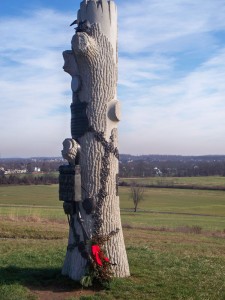Month: January 2012
Dobbin House (or The Gettysburg Brady Bunch)
January 19, 2012Here’s the story of a man named Dobbin: an educated Irish-born immigrant who left behind everything but his wife, Isabella, and voyaged to the New World, where he made his mark several times over. Reverend Alexander Dobbin acquired 300 acres of land in Gettysburg and, “four score and seven years” before the Gettysburg Address, erected the home that would be his family’s Gettysburg address. The house wasn’t small, and neither was his family; his wife bore him ten children before her death and he remarried to a widow with nine children of her own. The Brady Bunch had nothing on them!
Dobbin built his house to be more than just a dwelling; it was the culmination of his dream to establish a Classical School, the first to open its doors west of the Susquehanna River. Teaching a combination of liberal arts and theology, he quickly earned a reputation as an educator and brought prestige to the school. The high regard of his peers helped him in the movement to distinguish Adams County as a separate entity from York County.
Over the years, the house continued to contribute to the pages of history. In the time of the Underground Railroad (the mid-1800s), a clandestine crawl space sheltered the runaway slaves who risked it all for their freedom. When Lincoln delivered the Gettysburg Address, the residents of the house could have watched him from the balcony. And, in the aftermath of the Battle of Gettysburg, the house became a hospital, where Union and Confederate soldiers were treated with equal care.
Dobbin House is the oldest structure in Gettysburg still standing, and what a history it has! Restoration has allowed it to maintain its original beauty and great effort has been made to keep its furnishings and décor authentic. Although it used to host a large-scale Civil War diorama, it is now open to the public as a colonial tavern, renowned for its culinary offerings. You’ll eat well and you’ll drink deeply of the rich history that resides in Reverend Alexander Dobbin’s home.
Eat, drink, and be merry at the Dobbin House Tavern in Gettysburg!
The 90th Pennsylvania Infantry
January 4, 2012The battle-scarred skeleton of an oak tree marks the junction of Doubleday Avenue and Mummasburg Road in Gettysburg. From a distance, you might wonder why such a tree is left standing, why isn’t a lively sapling planted in its place? Only as you draw closer do you begin to realize that this forlorn tree is more than it appears…that it stands just a little too straight…that it, in reality, is a monument.
The 90th Pennsylvania Infantry is forever memorialized in the “Stalwart Oak Tree” just described, dedicated September 3, 1888. The sides are scorched, the limbs torn away, in an imitation of the artillery fire damage that claimed the lives of man and nature alike. Of the 208 men from the 90th who fought at Gettysburg, just 8 were killed, but 45 were wounded and 40 were missing. It doesn’t seem like a lot, on the grand scale, but that was 45% of their number.
Examine the Stalwart Oak with care—you’ll find, near the top, a nest with mother bird and hatchlings. Many have speculated over the meaning of this sculpted detail. There are two primary schools of thought: some believe it tells the story of a soldier under fire, risking his life to rescue the baby birds and their fallen nest; others postulate that the nest is symbolic, representing new life rising from the tatters of war, much like the Phoenix being reborn. Either way, the monument is a powerful testament that deserves to be revered.
What does the Stalwart Oak say to you? Read about another powerful monument here.
